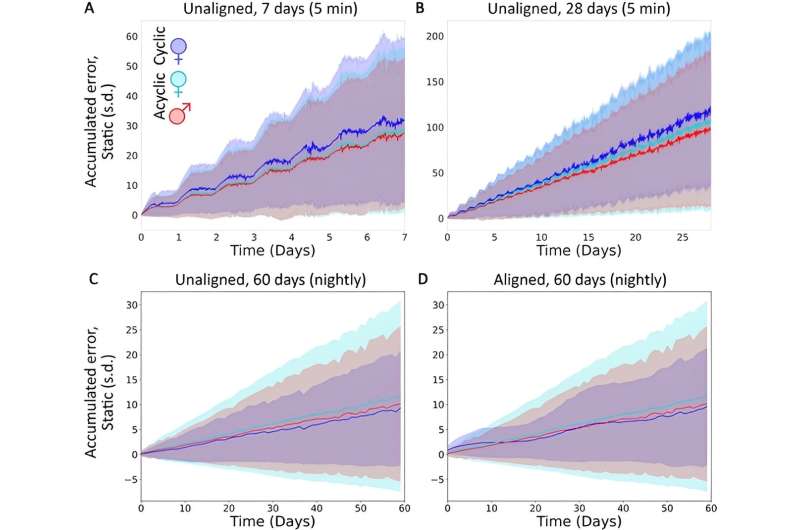This article has been reviewed according to Science X's editorial process and policies. Editors have highlighted the following attributes while ensuring the content's credibility:
fact-checked
trusted source
proofread
Women produce skin temperature data that is just as predictable as men

Women produce physiological data that is just as predictable as men, at least when it comes to skin temperature. This might seem like common sense, but variations in body signals due to menstrual cycles, such as temperature, were used as an excuse to keep women out of clinical studies for decades.
The data for the finding was gathered from a wearable device to continuously monitor the skin temperature of 600 people, half female and half male, over six months.
The team found that there were more differences between any two individuals in the study, whether male or female, than between the sexes. The researchers found that skin temperature mostly varied as a function of time of day and whether the subject was awake or asleep, across male and female participants.
Many women do not have large menstrual cycles, and neither cycles nor sex accounted for significant differences in variability of any group. It's the first time that a study has continuously tracked human skin temperature over such a long period of time, to the best of the researchers' knowledge. The team published their findings in the journal Biology of Sex Differences.
Despite guidelines from the National Institutes of Health that require studies to include females and minorities in clinical studies, women are still disproportionately excluded from research, particularly in drug trials. This is due in part to concerns that menstrual cycles would introduce too many variables in the data.
And despite the harm to women that results from using medicines designed for men, including higher overdose and side effect rates, no one had yet looked at continuous physiology signals across large groups of men and women to see if women's cycles really did make the data harder to analyze—until now. The study didn't find any statistically significant differences, showing that concern is not warranted.
The team included researchers from the San Diego Supercomputer Center, the Halicioglu Data Science Institute and the Jacobs School of Engineering at the University of California San Diego as well as the UC San Francisco Osher Center for Integrative Health.
The UC San Diego team has been working with the UC San Francisco team, led by co-senior author Dr. Ashley E. Mason, since 2020 to gather wearable data from around the world and develop tools for detecting disease outbreaks. "If the point is that we can now use wearables to track health over big groups of people, then it makes no sense to exclude whole groups of people from the research" said Mason, a sleep clinician and principal investigator of the broader TemPredict project from which this study grew.
The team chose to track skin temperature because it's essentially a way to monitor the state of a person's endocrine system, said Ben Smarr, the paper's corresponding author and a professor in the Shu Chien Gene Lay Department of Bioengineering and the Halicioglu Data Science Institute at the University of California San Diego. Temperature has been tied to hormonal changes, daily rhythms and women's health states by previous research.
"In this study, the difference between two men is bigger than the difference between the average man and the average woman," said Lauryn Keeler Bruce, the paper's first author and a Ph.D. student in the Biomedical Informatics and Systems Biology program at UC San Diego. "In addition, the variability between men and women is not statistically significant."
Smarr and colleagues used the ŌURA ring, a smart wearable produced by Finland-based company Oura Ring to track skin temperature in the study. The device can also track heart rate, activity, and provides sleep tracking. The ŌURA Ring has become a go-to research tool because it's easy to use and delivers high-quality data. It has been used in recent publications about medical device adherence, predicting pregnancy outcomes, and tracking COVID-19.
Through statistical analysis the team developed, they found, in women who cycled, a pattern of variation in nightly maximum skin temperature over a roughly 28-day period, consistent with menstrual cycles. This was not unexpected, as temperature monitoring has been used as a tool to track fertility across many cultures. If anything, the pattern made variations easier to predict for the subjects that experienced it. The data for these females was more predictable than for all the other subjects in the study.
"This analysis confirms that ovarian rhythms do affect temperature," the researchers write. "This analysis does not suggest that these rhythms make any given measurement more prone to error."
Researchers also pointed out that none of their female subjects constantly had a 28-day cycle. "No one was a textbook example," Keeler Bruce said.
Researchers hope that other teams will adopt their methodology. Being able to continuously monitor physiological signals, such as temperature, is crucial in capturing a more accurate picture of a person's health, Smarr said. "In order to know what disturbs a pattern, you need to know what the pattern is in the first place," he said.
The team plans to examine data from pregnant people throughout pregnancy next. They also plan to examine the differences in activity patterns between male and female subjects.
More information: Lauryn Keeler Bruce et al, Variability of temperature measurements recorded by a wearable device by biological sex, Biology of Sex Differences (2023). DOI: 10.1186/s13293-023-00558-z





















